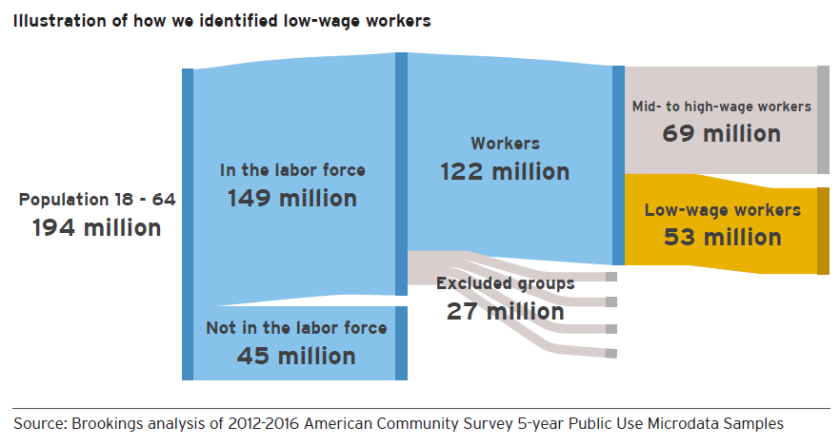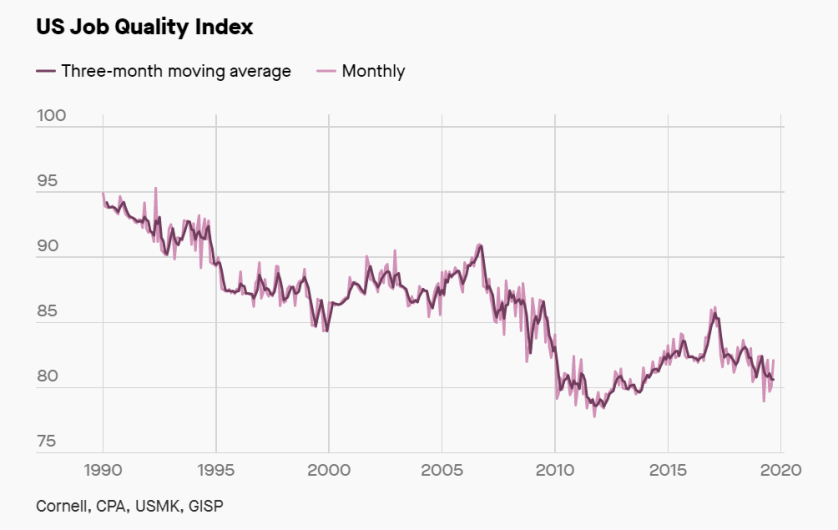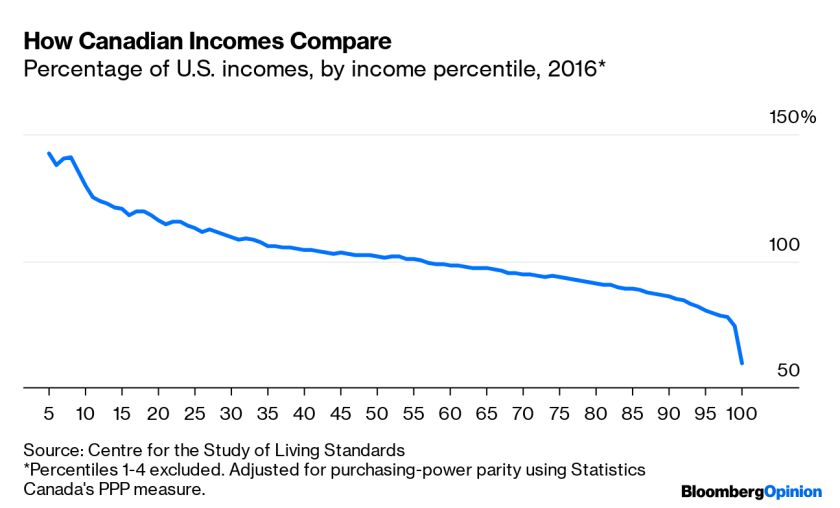https://www.bradford-delong.com/2019/12/what-is-the-political-economic-agenda-after-piketty.html
Introduction: Let me write, overwhelmingly, about inequality understood as inequality between people who regard themselves as members of a common culture, economy, nation. There is the separate issue of inequality between the different cultures, economies, nations that make up the world, but let me leave that for the very end, and then deal with it only briefly.
History of Inequality: For most of human history since the invention of agriculture, typical settled human societies have been about 80% as unequal as they could possibly be: were anything to stretch out the distribution of income and wealth by more than an additional 20%, and working-class women would have become too skinny to ovulate regularity and working-class children would have had compromised immune systems, and so the population would have failed to reproduce itself. The typical economy's Gini index was about 45 or so (the same Gini value as if 72% of wealth and income were evenly divided among the top 28%, and the rest evenly among the rest)—with New Spain in the eighteenth century estimated up at above 60 (the same Gini value as if 4/5 were evenly divided among the top 1/5, and the rest evenly among the rest) and the Kingdom of Naples and China estimated down below 30 (the same Gini value as if 65% were evenly divided among the top 35%, and the rest of income evenly among the rest).
Then came two revolutions: The Democratic Revolution brought the transfer—at least in theory—of power from military and scholarly-religious elites to the people, so that gross inequality was no longer necessarily the outcome of politics. The Industrial Revolution brought the possibility of mass prosperity: technologies, especially materials science and non-human power sources, organization, and education give middle-class people in the global north today standards of living that even the richest and sometimes the gods of past eras would envy.
Indeed, today some three-quarters of humanity are vastly richer than our preindustrial ancestors. Indeed, today one-third of humanity are democratic enough to rule themselves in more than a meaningless shadow-puppet manner. By the same token, however, our richer societies could be even more unequal than those in the past: when even the poor have enough to eat, Malthusian forces no longer limit how much inequality an economy can generate.
And there was a strong belief in the global north in the years after World War II that inequality, or at least gross inequality, had been largely solved as a problem. Social insurance made the lives of those whom the market had dealt bad cards. High progressive tax cuts made those who had been lucky enough to have been dealt good cards by the market pay their fare share of the burden of maintaining the society and economy that had made them rich. Keynesian macroeconomic policies had kept employment full.
But then things changed. Today we stand at the end of a forty-year period during which inequality within the overwhelming majority of the world's economies has been increasing. In the United States—where the rise has been among the most extreme—the top 1% have gone from 9% to 22% of income, and the top 0.01% from 1% to 5% of income. Our societies today are, on balance, neither clearly more nor clearly less relatively unequal than our predecessors' were. This is not to say that there are no important differences: we have Belgium, the Netherlands, and Denmark with Gini coefficients of 28, Japan with a Gini of 32, the United States with a Gini of 42, Brazil with a Gini of 53, and South Africa with a Gini of 63. But substantial inequality has—with the exception, perhaps, of the global north in the post-World War II generation, been a feature of human societies since before the days when Gilgamesh—the Man Who Had Seen All Things—ruled Uruk by virtue of his status as "perfect form... two-thirds god and one-third man", and made "his men stand at attention, longing for his orders.... Gilgamesh does not leave a daughter to her mother, nor the maiden to the warrior, nor the wife to her husband..." Something like Vilfredo Pareto's Iron Law, that societies tend toward the top 20% having 80% of the wealth and income—a Gini of 60—seems the way to bet.
&&Thomas Piketty's New Book, Capital and Ideology**: On September 12, 2019, Thomas Piketty published Capital et Ideologie, the follow-up to his 2013 Le Capital au XXIe Siècle (with the second published in English as Capital in the Twenty-First Century, and the first to be published next year in English as Capital and Ideology).
Capital in the Twenty-Fist Century made a very powerful argument that the era of low inequality after World War II had been a historical anomaly, and that those who had interpreted advanced capitalism plus political democracy as leading to a stable political-economic income of successful social democracy had been wrong. The argument of the book was, at bottom, a voter-inattention rent-seeking argument. The rich have a great interest in taking steps to make sure that the government regulates the economy in order to keep the average rate of profit around 5% per year. The voters have no great understanding of what policies would be effective at pushing the average rate of profit up or down. Over time, therefore, there is pressure pushing toward a policy equilibrium maintaining this 5% per year rate of profit. If, therefore, the economy's real growth rate is less than 5% per year, and if the combination of taxes, philanthropy, and conspicuous consumption are not enough to make up the gap, then the wealth of the rich will grow relative to the income of society. And as their relative wealth grows, their ability to use their income and wealth as social power to further entrench their desire for a high rate of profit in society's political economy will grow as well.
Capital and Ideology is making a different argument. In some ways, it retreats from the rent-seeking society implicit model of Capital in the Twenty-First Century. In that first book, it was the ability of the rich to deploy their social power to gain a form of ideological hegemony over society that led to the confusion of voters and to the absence of organized counter pressure against policies to boost and then maintain a high rate of profit. In Piketty's new book, there are political organizations that understands how to make social democracy work for pretty much everybody: to provide enough space for markets, enough in the way of incentives, and enough in the way of public support for economic growth to produce rapidly increasing prosperity, but also enough in the way of redistribution to sharply moderate inequality. But then, starting around 1980 in Piketty's telling, these political organizations lose their way. What had been the center-right becomes a "merchant right", devoted to advancing the interests of plutocrats by seeking a mass base by the neofascist strategy of triggering the base's resentment of those to whom relatively equal social democracy was giving "more than they deserve". What had been the center-left becomes a "Brahmin left", focusing on policies that please and advance not the working class and the upwardly mobile but rather those who have taken advantage of social insurance and social-democratic institutions by becoming upwardly mobile via a high level of education. One political party advances the interest of those rich via inheritance and managerial entrepreneurship. The other advances the interest of those rich via education and professional status. And the broader public interest in a broadly middle-class society—and, indeed, in preventing the closing-down of the roads for upward mobility—is left by the wayside.
Perhaps this new book has struck a nerve just like the old one did. The uncredited author of Bloomberg's email newsletter is a little too eager to dismiss Capital in the Twenty-First Century as "a massive tome... rarely read to completion", and then call Capital and Ideology "even longer!... not exactly a worthy follow-up... impractical." It certainly does suggest that economic research on inequality and political economy action to reduce it or at least moderate its deleterious effects should pursue additional directions to those suggested by Piketty in his first book.
The Economic Research Agenda Suggested by Piketty's First Book: The first book, Capital in the Twenty-First Century, suggested an economic research agenda.
Its first question is: is Piketty right in supposing that the post-World War II social-democratic equitable-growth era was a fragile and unstable piece of good luck that will be hard to rebuilt? Here the answer still has to be "perhaps"—and further investigation of this question was, remains, and long will be the highest priority of those questions pursued by those stimulated by or reacting to Piketty.
Its second question was and remains: do we care? Inequality per se is of little importance if inequality brings with it faster growth. Here, too, economists have much work to do. But by now the overwhelming presumption is that there is no such thing as a durable tradeoff between equality and efficiency in the sense of Arthur Okun's famous "leaky bucket". Adam Smith 250 years ago could look benignly on the inequality of Georgian Britain: the inequality that the market created was largely based on luck, but enough was based on enterprise that your average working-class Briton lived in greater material comfort than an African king, and the consumption of the rich was limited by the size of their stomachs, and thus most of what they spent even on themselves was in fact a contribution to the leisure and the comfort of their underlings.
We cannot be so complacent. We see that plutocrats are those whose wealth is most likely to be "creatively destroyed" by a dynamic, growing economy, and hence inequality as in the long run the enemy rather than the friend of greater prosperity. We see the status consequences of inequality as very damaging to the human organism, and thus to human well-being, in a way that simply counting up real income measures cannot see. And, of course, anyone who has looked at the distribution of medical care in the United States and our abysmal health outcome statistics relative to other rich countries cannot help but see that inequality is a factor that leads enormous investments of resources to deliver little of ultimate value in the sense of human well-being and human satisfaction. The point generalizes beyond the health sector: an unequal economy is one that is lousy at turning productive potential into societal well-being. We could be doing better—and with a more equal income and wealth distribution would be. We do care. We must care.
And there is a third question, one that cries out most for more research. Suppose Piketty is right, and mixed-economy social democracy is unstable, tends to collapse back into the absorbing state of the high inequality of Vilfredo Pareto's Iron Law, from which it can be knocked out of only by social-historical catastrophes that redeal society's deck of cards. As Branko Milanovic has pointed out, mixed-economy social democracy is only one of the possible institutional setups. There are others. Forms of property that yield rights to shares of society's total product are themselves under the control of society. Economist Michael Spence has recently noted that America's Business Roundtable has abandoned its long-standing commitment to so-called "shareholder primacy". A straw in the wind? As more and more of society's wealth creation is bound up in the form of corporations and of the associations of corporations that are global value chains, more and more of the economy's true institutional setup becomes a product of technical legal rules and bureaucratic procedures. Piketty sees distribution as driven by labor on the one hand and capital—all forms of wealth that command rights to income—on the other. But that is so only because history has made it so.
More than one and two-thirds centuries ago Karl Marx dismissed Branko's observations as reflecting an irrational and unattainable longing for a "petty-bourgeois socialism": something that could never be attained, and that if it did by some miracle develop by accident, could never be maintained. But that casual dismissal does not mean that Milanovic is wrong here.
Piketty's Second Book's Suggestion About a Political-Economy Research Agenda: This second book, Capital and Ideology, suggests a political-economy research agenda—two political-economy research agendas in fact.
The first political-economy research agenda is to understand what happened to the center-right. The center-right was, around 1980, transformed from a center-right that sought to make social democracy more productive into the "merchant right" described by Piketty. In the process, it transformed itself in country after country from a political movement aimed at representing those who expected to gain from a growing market or mixed economy to a movement that aims at representing those who think they have something to lose from economic or structural change, or simply from the passage of time or the widening of opportunity. To some degree this transformation reflected deceasing optimism among targeted potential voters: the end of western European and Pacific rim catch-up "supergrowth" and the coming of high unemployment in Europe starting in the 1980s and stagnation to Japan starting in the 1990s made many people no longer expect to gain from the market. The original hope was that a pruning-back of the less efficient pieces of social democracy and a small widening of inequality to improve incentives for entrepreneurship and enterprise would reinvigorate growth, and restore the confidence of those who had hoped to be winners but found out that it was not so. But the diagnosis was faulty. The rise in inequality did not restore growth. And hence the focus shifted to one of seeking to punish those whom social democracy had unjustly enriched, and allowed to think that they were above their proper station.
But this is only the case to some degree. This is not a full explanation by any means of the rise of politicians like Viktor Orban or Boris Johnson or Donald Trump or Marine Le Pen, or of their inability to find a set of coherent and growth-boosting policies to substitute for—or even complement—their focus on the internal and external enemies of those who are fully and properly Magyar, English, American, and French.
The second political-economic research agenda is to understand what happened to the center-left. It was, around 1980, transformed from a center-left that sought more upward mobility, more social insurance, and a strong labor movement to one whose core is those rich via education and professional status, and which focuses on issues more of cultural liberalism than of political-economic social democracy. Piketty sees the center-left as, to a great degree a prisoner of its own success. The big winners from post-World War II social democracy were those from modest backgrounds for whom full employment and low-cost education opened up opportunities. education and high-income possibilities to the people who in the 1950s and 1960s came from modest backgrounds. These winners continued to support and vote for the center-left. But their interests and visions were different: the transformation of the Labour Party from Clement Attlee to Tony Blair in Britain, for example. Once again, there is considerable truth in this story that Piketty tells. Once again, it is very far indeed from being a complete or a satisfactory explanation.
It is very much worth noting that the policy recommendations found at the end of Capital and Ideology seem less attuned to the argument of the core of the book and more attuned to the argument of Capital in the Twenty-First Century. Near-confiscatory taxes on plutocrats to finance the distribution of substantial financial nest eggs to working-class young adults seems tailor-made to unwind some of the social power of plutocrats and set in motion a virtuous cycle by which their ability to maintain the 5% per year rate of profit that supports their wealth is undermined by a loss of that wealth and leads to a future decline in their ability to work the levers of the rent-seeking society in their own interest. But in Capital and Ideology the central political-economic problem is not that plutocratic wealth exercises a form of hegemony and undermines the ability of the public sphere to engage in practical reason. In Capital and Ideology the central political-economic problem is that the center-left and the centre-right have become unmoored from the economic interests of those whom they represent or ought to represent: declining into a form of neofascism on the right, and to a focus on cultural issues rather than economic mobility and equitable growth on the left. The democratic people still have the power to command policies in their economic interest. But the transmission belts by which that power is transmitted through political parties and into government policy are broken. Fixing that would seem to call for political, ideological, and organizational reform, not for high tax rates and a universal basic income that could, in any event, never be implemented until after successful political, ideological, and organizational reform.
In Addition: And we should not miss sight of the very important facts with respect to inequality between economies and societies. Today we stand at the end of a forty-year period in which global inequality has been decreasing not because countries' economies have been drawing closer together in relative wealth but because the two overwhelmingly most populous countries of China and India hav been successful in moving from poor to middle-income status: on a logarithmic scale, Chins and India were only one-seventh of the way from Ethiopia to the United States in the late 1970s, and they are three-fifths and two-fifths of the way today
-- via my feedly newsfeed











